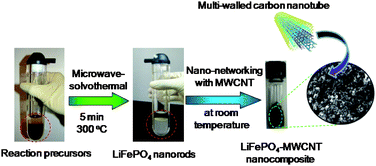Nanoscale networking of LiFePO4nanorods synthesized by a microwave-solvothermal route with carbon nanotubes for lithium ion batteries
Abstract
LiFePO4nanorods with a controlled size have been synthesized by a rapid microwave-

* Corresponding authors
a
Electrochemical Energy Laboratory & Materials Science and Engineering Program, The University of Texas at Austin, Austin, TX, USA
E-mail:
rmanth@mail.utexas.edu
Fax: +1-512-471-7681
Tel: +1-512-471-1791
LiFePO4nanorods with a controlled size have been synthesized by a rapid microwave-

 Please wait while we load your content...
Something went wrong. Try again?
Please wait while we load your content...
Something went wrong. Try again?
T. Muraliganth, A. V. Murugan and A. Manthiram, J. Mater. Chem., 2008, 18, 5661 DOI: 10.1039/B812165F
To request permission to reproduce material from this article, please go to the Copyright Clearance Center request page.
If you are an author contributing to an RSC publication, you do not need to request permission provided correct acknowledgement is given.
If you are the author of this article, you do not need to request permission to reproduce figures and diagrams provided correct acknowledgement is given. If you want to reproduce the whole article in a third-party publication (excluding your thesis/dissertation for which permission is not required) please go to the Copyright Clearance Center request page.
Read more about how to correctly acknowledge RSC content.
 Fetching data from CrossRef.
Fetching data from CrossRef.
This may take some time to load.
Loading related content
